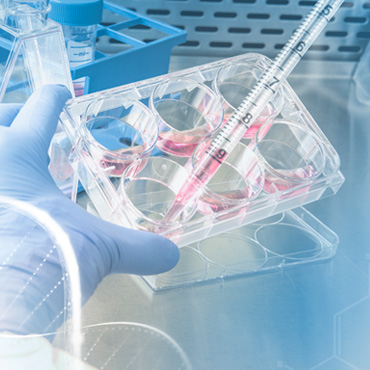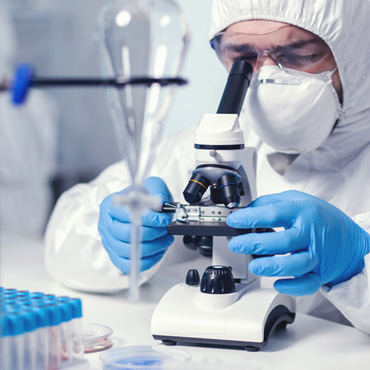Neuropathic Pain
Neuropathic Pain is pain caused by somatosensory nervous system injury or disease. Its prominent symptoms are spontaneous pain, hyperalgesia, and allodynia, and the sense of pain is extremely strong. Owing to the complex mechanism, conventional painkillers lack effectiveness. Recently, research on the treatment of NP by stem cells is increasing and promising results have been achieved in preclinical research.Neuropathic pain is a complex, chronic pain state that usually is accompanied by tissue injury. It's a type of pain that can occur as a result of damage, dysfunction, or injury to the nervous system, either in the peripheral nerves (those in your body) or the central nervous system (the brain and spinal cord). This nerve damage can be caused by a variety of conditions or events such as diabetes (which can lead to diabetic neuropathy), shingles, certain types of cancer, chemotherapy drugs, injuries to the brain or spinal cord, multiple sclerosis, stroke, and HIV infection, among others.
Neuropathic pain is not a single disease, but a syndrome of multiple symptoms. The pain associated with neuropathic pain can be described in various ways such as burning, tingling, numbness, shooting pain, or like an electric shock. Some people may also experience hypersensitivity to touch or cold, a condition known as allodynia. Each individual’s experience with neuropathic pain is unique, and thus treatment plans are often tailored to the specific needs and circumstances of the individual.
Diabetic Neuropathy
Diabetic Neuropathy Is a type of nerve damage that can occur if you have diabetes. High blood sugar (glucose) can injure nerves throughout your body. Diabetic neuropathy most often damages nerves in your legs and feet. Depending on the affected nerves, symptoms of diabetic neuropathy can range from pain and numbness in your legs and feet to problems with your digestive system, urinary tract, blood vessels, and heart. Some people with nerve damage due to diabetes have no symptoms.Four Main Types of Diabetic Neuropathy:
1) Peripheral neuropathy: This is the most common type and affects the peripheral nerves, typically in the feet, legs, hands, and arms. Symptoms can include numbness or reduced ability to feel pain or temperature changes, tingling or burning sensation, sharp pains or cramps, increased sensitivity to touch.
2) Autonomic neuropathy: This type affects the autonomic nerves that control the heart, bladder, stomach, intestines, sex organs, and eyes. Symptoms can include hypoglycemia unawareness, bladder problems, constipation, gastroparesis, and erectile dysfunction among others.
3) Proximal neuropathy: This type involves nerve damage leading to pain in the hips, thighs, or buttocks and leads to weakness in the legs.
4) Focal neuropathy: This involves damage to specific nerves, most often in the head, torso, or leg, causing muscle weakness or pain.
Stem Cells Treating Neuropathy
In this review, we introduce the current treatment strategy, and the development of stem cell therapy, we collected experimental and clinical trial articles of many kinds of stem cells in the treatment of neuropathic pain and we analyzed and summarized the general efficacy and mechanism of stem cells in the treatment of neuropathic pain. We found that stem cells play a role in peripheral mechanism, central mechanism, and disinhibition of spinal cord level that lead to neuropathic pain, so they are more effective in analgesia and treatment of neuropathic pain.In terms of neuralgia, initially, researchers investigated the ability of stem cells to replace damaged nerve cells and transport nutritional factors to lesion sites; however, more recent research has shown that the effectiveness of stem cells against NP is mainly related to the two-way interaction between stem cells and resident cells in the damaged microenvironment. Stem cells have the potential to block degeneration processes, inhibit apoptosis, and enhance survival/recovery in injured and uninjured nerves. Stem cells play nerve repair roles in both the central nervous system (CNS) and the peripheral nervous system (PNS). They can release a large number of neurotrophic factors, including epidermal growth factor, BDNF, NT-3, CNTF, basic fibroblast growth factor (bFGF/FGF-2), hepatocyte growth factor, and vascular endothelial growth factor (VEGF). At present, a variety of stem cells including bone marrow mesenchymal stem cells (BMSCs), human amniotic fluid-derived mesenchymal stem cells (hAFMSCs), adipose-derived stem cells (ADSCs), and GABAergic intermediate neuron progenitor cells have strong therapeutic potential in the treatment of NP and the results are promising.
Neuroprotection and Promotion of Axonal Myelin Regeneration: Damage to nerves results in unusual neuron activity, triggers the degeneration of nerve fibers, and alters the expression and makeup of channels, leading to ectopic discharges. This spontaneous ectopic activity in nerve endings or axons is a key factor in spontaneous pain and contributes to irregular pain responses. Activating transcription factor 3 (ATF3) is commonly recognized as an indicator of injury in dorsal root ganglion (DRG) neurons. The findings clearly illustrate that stem cell therapy can lessen chronic nerve damage.
Reduced Apoptosis and Autophagy of Spinal Cord Cells: As mentioned in the peripheral mechanism, the control of nerve injury is an important part of preventing the development of NP. Stem cells not only promote the recovery of peripheral nerve injury but also play the same role in the central nervous system. Lin et al. found that elevated TUNEL expression, a marker of apoptosis in the spinal cord, was reversed when ASCs were subcutaneously transplanted as treatment in the burn rat model of NP.
Conclusion:: The mechanism of NP is extremely complex, and it is difficult to achieve good results by using current clinical first-line drugs. Owing to the two-way interaction between stem cells and resident cells in the damaged microenvironment, stem cells can play multiple roles, such as peripheral, central, and spinal cord disinhibition, which significantly reduces the occurrence of clinical symptoms including spontaneous pain, hyperalgesia, and hyperalgesia. We look forward to the summary and analysis of the mechanisms related to the treatment of NP by stem cells, which can provide theoretical reference for preclinical and clinical research in the future and contribute to the field of stem cell therapy and pain.
Treating Neuropathy At CellMex:
What Type of Stem Cell Is Used?
We currently treat NP with stem cells, specifically Induced Pluripotent Stem Cells; these are sourced directly from the patient's own adipose tissue of which we re-program and differentiate into a neural lineage forming Neural Progenitors then further into Neurons.Treatment Protocol:
This type of treatment requires patient setup a consult, and if in agreement proceed to an appointment for stem cell harvest from patient. Then we proceed to stem cell reprogramming in laboratory. There we must be able to manipulate the patient's own stem cells into iPSC's, so that they possess the necessary characteristics for successful differentiation and transplantation.Induced pluripotent stem cells (iPSCs) are not considered differentiated stem cells. Rather, they are pluripotent, which means they have the ability to differentiate into any cell type in the body. Differentiation is the process by which these unspecialized stem cells become specialized cell types with specific functions. The differentiation of iPSCs into a nerve cell, also known as a neuron, involves a series of steps. Here's a general outline of the process:
- a) Induction of Neural Lineage: First, the iPSCs need to be directed towards a neural lineage. This is achieved by changing the cell culture conditions, such as the growth medium and the addition of certain growth factors or small molecules. For example, dual SMAD inhibition (using molecules like Noggin and SB431542) can be used to encourage the cells to form neural precursor cells.
- b) Formation of Neural Progenitors: Under the influence of these molecules, the iPSCs begin to differentiate into neural progenitor cells, an intermediate cell type that can further specialize into various types of neurons and glial cells. These cells will form what's called a "neural rosette" in culture, which is a sign that they are becoming neural cells. c) Differentiation into Neurons:, Neural progenitor cells are then further differentiated into neurons. This typically involves changing the growth medium and adding different sets of molecules to guide their differentiation. For instance, factors such as retinoic acid, brain-derived neurotrophic factor (BDNF), or other specific neurotransmitter-related factors could be used, depending on the specific type of neuron that's desired (e.g., dopaminergic neurons, motor neurons, etc.).
d) Maturation and Validation:, The resulting neurons are then allowed to mature in culture, after which they can be tested to confirm their identity. This testing usually involves checking for the expression of neuron-specific proteins and their ability to generate electrical activity, which is a key function of neurons.
*This is a 10 to 12 week process involving: Harvesting, Isolation, Culture, Transfection, Induction, Selection & Expansion and Validation.
Cost of Stem Cell Therapy for Peripheral Neuropathy
The initial expense for the treatment varies between $15,000 and $40,000. This price variation is based on the complexity involved in reintroducing the cells into your body. For instance, treating spinal conditions demands involvement from multiple physicians to administer the cells back into your body, which increases the cost due to the participation of numerous doctors in the procedure. For the majority of patients, the initial therapy fees of $15,000 suffices; however, certain conditions may necessitate follow-up treatments, which are offered at reduced fees.Benefits of Stem Cell Treatments:
The potential benefits of treating diabetic neuropathy with induced pluripotent stem cells (iPSCs) primarily hinge on their inherent properties of self-renewal and differentiation. Here are some of the potential benefits:-
Cell Replacement Therapy:
Since iPSCs have the ability to differentiate into any cell type, they could be used to generate new, healthy nerve cells to replace those damaged by diabetic neuropathy. This could potentially restore lost nerve function and alleviate symptoms. Targeted Therapy Development:
iPSCs derived from patients with diabetic neuropathy could be used to create patient-specific disease models in the lab. These models can be used for better understanding of the disease at a cellular level, which could lead to the development of new, targeted therapies.
Minimized risk of rejection: In cases where autologous stem cells (stem cells derived from the patient's own body) are used, there is a reduced risk of rejection or adverse immune reactions. This is because the cells are genetically matched to the patient, minimizing the need for immunosuppressive drugs.
Personalized Medicine:
Since iPSCs can be derived from an individual patient's own cells, treatments based on these cells would be patient-specific. This could potentially reduce the risk of immune rejection, and enable the development of more personalized treatments..
Treatment of previously incurable conditions: Stem cell therapy holds promise for treating conditions that were previously considered incurable or had limited treatment options. Examples include certain types of neurological disorders and spinal cord injuries. treatments of diabetic neuropathy with iPSCs remain largely in the realm of translational research and have not yet become standard clinical practice in Western Medicine. The process of reprogramming cells to become iPSCs and then directing them to differentiate into desired cell types is complex.
Availability of Stem Cell Treatments:
The costs and availability of stem cell therapy and treatments can vary significantly depending on several factors, including the type of stem cell therapy, the country or region where the treatment is sought, the specific medical condition being treated, and the healthcare provider or clinic offering the therapy. For more specific price details View Our PricesNormal Treatment Protocol & Recovery Procedures When Undergoing Stem Cell Transplant At CellMex
The treatment and recovery procedures for a stem cell transplant or treatment can vary depending on the specific type of transplant and the medical condition being treated. However, here is a general overview of the typical steps involved in a stem cell transplant:- 1) Preparatory Phase
- 2) Stem Cell Collection
- 3) Transplantation
- 4) Recovery And Supportive Care
- 5) Engraftment & Immune System Recovery
- 6) Follow-up Care



